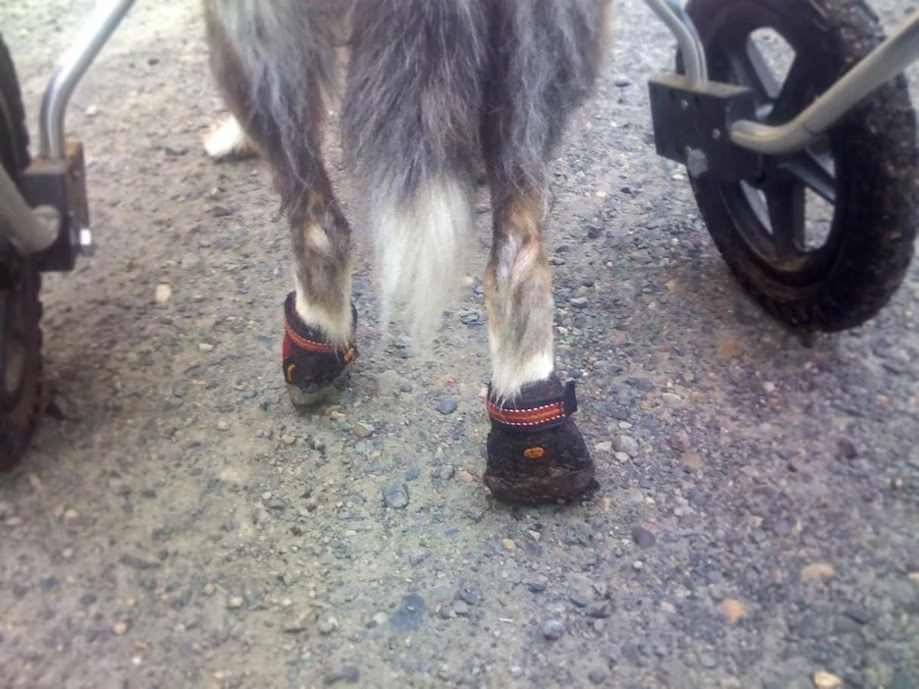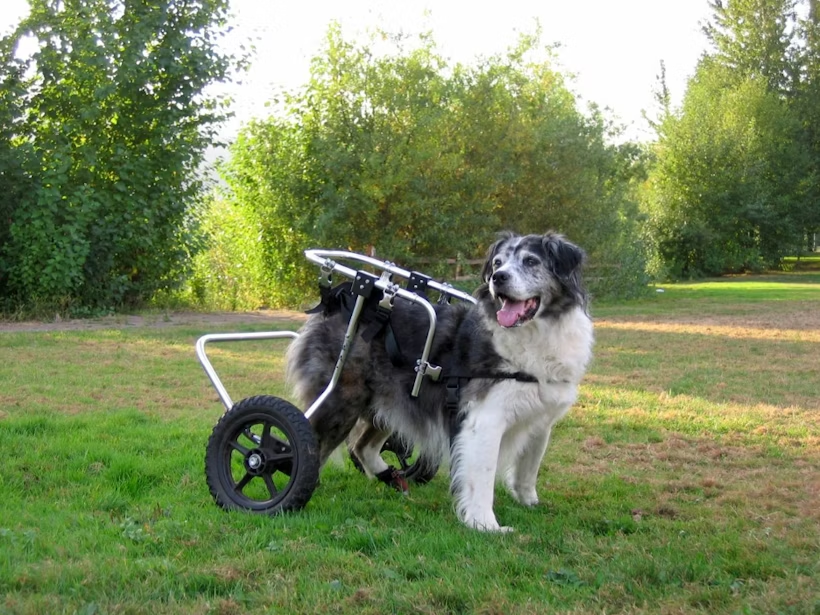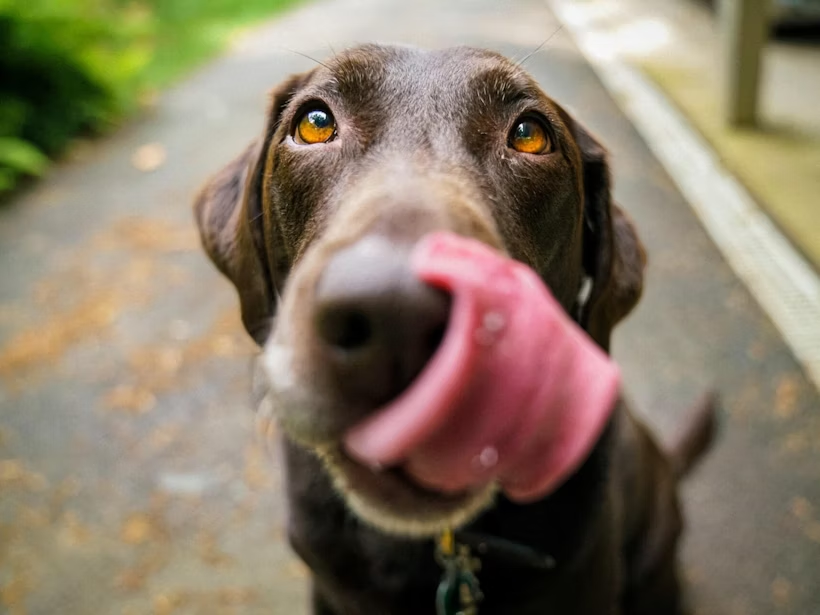Degenerative myelopathy (DM for short) is a progressive neurodegenerative disease with a late adult onset in dogs.
Receiving a diagnosis of DM can be scary. But knowledge is power! Read on for an overview of the disorder and what you can do if your dog has it.
What are the signs of degenerative myelopathy in dogs?
Clinical signs of this disease typically appear in affected dogs around eight years of age. They start in the hindlimbs and may include:
- Weakness
- Loss of coordination
- Scuffing or dragging of the toes
Over time, these signs worsen, and the effects spread toward the front limbs as nerves in the spinal cord fail to transmit impulses to and from the muscles.
Note: Dogs with DM can often maintain a great quality of life—even after the onset of clinical signs. And not all dogs with the risk variant will necessarily develop the disorder.
Is degenerative myelopathy painful to dogs?
Thankfully, DM doesn’t appear to be painful. That said, additional conditions (such as arthritis) can exacerbate the disorder and cause some discomfort. If this seems to be the case for your dog, ask your veterinarian about ways to make them more comfortable.

What causes DM in dogs?
Scientists haven’t identified the exact cause of this disease. But in 2009, researchers discovered a link between an abnormal variant in the SOD1 gene and an increased risk of developing degenerative myelopathy.
Did you know? Degenerative myelopathy is similar to amyotrophic lateral sclerosis (ALS), or Lou Gehrig’s Disease, in humans. So, studying DM in dogs could lead to discoveries that help people, as well.
DM in dogs is considered an autosomal recessive disorder with incomplete or variable penetrance. In other words, the dogs most at risk are those with two copies (one passed down from each parent) of the abnormal genetic variant associated with DM.
However, not all dogs with two copies develop the disease. And some pups with only a single copy develop clinical signs. Though we don’t yet know for certain why this is, experts have theorized that additional genetic and environmental factors may be at play.
In fact, a 2016 study identified what researchers termed a “modifier locus” in the Pembroke Welsh Corgi. Pembrokes carrying additional risk alleles at this locus were more likely to develop DM, and they tended to show clinical signs at an earlier age. This suggests that there are likely other genetic factors that may influence a dog’s risk of DM.

How to test your dog for degenerative myelopathy
DM used to be known as a “diagnosis of exclusion,” meaning that a veterinarian had to test for—and rule out—other causes of the clinical signs seen in the disorder. Such a process can be expensive and frustrating for both the pet parent and the veterinarian.
Fortunately, genetic testing for degenerative myelopathy in dogs is now available. And though a positive genetic test for SOD1 doesn’t definitively tell us whether or when a dog will develop clinical signs of DM, it can provide clues when trying to diagnose what is otherwise a relatively nonspecific neurologic disorder.
Veterinarians may still recommend additional testing for pups with two copies of the abnormal SOD1 variant. This is to rule out diseases with similar clinical signs or concurrent issues that may contribute to the overall clinical presentation.
Which breeds are most at risk for developing DM?
Some breeds seem to get DM more frequently than others. Originally known as “chronic degenerative radiculomyelopathy,” DM was once thought to occur only in German Shepherds. But studies later found the SOD1 mutation to be associated with disease in other breeds, including:
Researchers have also identified a separate mutation in the SOD1 gene associated with DM in the Bernese Mountain Dog. The Berner mutation does not appear to be linked to disease in any other breeds.

Is degenerative myelopathy treatable?
There is no known cure for degenerative myelopathy. But if your pup has DM, you can support their quality of life in several ways.
Early in the course of the disease, when the main signs are uncoordinated movement in hindlimbs, dragging of toes, and weakness in the rear:
- Keep your dog at a lean, healthy weight.
- Slow the progression of signs through physical therapy and exercise.
- Use durable booties to protect your dog’s paws (if they scuff the ground).
- Explore harness options that allow you to help lift your pup if they have trouble.
Later in the disease, when hindlimb weakness progresses to hindlimb paralysis and incontinence:
- Try using a cart designed to help dogs with DM move around unaided.
- Ask your veterinarian about tips for helping your pup go potty.
- Consider relocating your dog to an environment where messes will be easy to clean up.
In the final stages of degenerative myelopathy, affected dogs will also develop forelimb signs and may begin to have trouble breathing or swallowing. At this point, it’s best to discuss options with your veterinarian.
Can you still breed a dog with one or two copies of DM?
Yes, but it’s not a simple decision. Keep the following in mind:
- A dog with two copies of the SOD1 mutation bred to a clear mate (one with two normal copies of the gene) will produce offspring with one copy of the abnormal variant (carriers).
- A dog with one copy bred to a clear mate will produce litters that are roughly 50% clear and 50% carriers.
- A dog with two copies of the abnormal SOD1 gene bred to a dog with one copy will produce pups that are at risk for DM.
Note: In some breeds, the frequency of the variant associated with DM is high enough to warrant a more conservative approach when trying to breed away from genetically at-risk dogs.
When interpreting genetic tests on breeding dogs, remember that each result is only part of the larger picture. Haphazardly breeding away from traits simply because they can be tested may harm the breed’s diversity and overall health.
Test for degenerative myelopathy and 200+ other health conditions.
As the world’s most comprehensive dog DNA test, Wisdom Panel™ Premium can tell you more about your pup than you ever thought possible. All so you can provide better care.
Explore Premium














